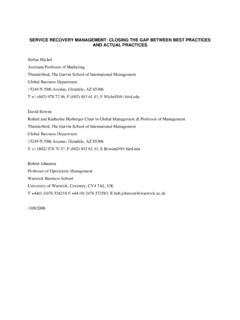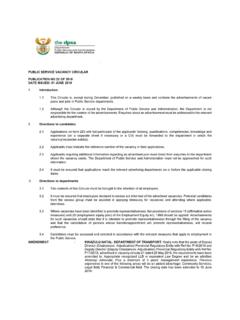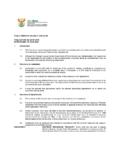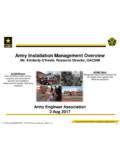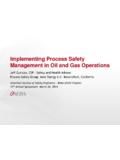Transcription of SERVICE RECOVERY MANAGEMENT: CLOSING THE …
1 SERVICE RECOVERY management : CLOSING THE GAP BETWEEN BEST PRACTICES AND ACTUAL PRACTICES by Stefan Michel, David Bowen and Robert Johnston EXECUTIVE OVERVIEW Best practice in SERVICE RECOVERY has been well documented in the past 20 years and is familiar to many throughout industry and academia. Nevertheless, overall customer satisfaction after a failure has not improved, and many managers claim their companies cannot respond to and fix recurring problems quickly enough. We therefore explore the apparent gap between best and actual practices in SERVICE RECOVERY management . We summarize best practice principles which we categorize as process RECOVERY , employee RECOVERY , and customer RECOVERY then illustrate how the tensions among those three discipline-based approaches inhibit a firm s ability to implement a cohesive SERVICE RECOVERY strategy.
2 Successful SERVICE RECOVERY management instead requires top management commitment to integration around a SERVICE logic, fitted to shared values and strategy, as reinforced by the seamless collection and sharing of information and RECOVERY metrics and rewards. This integration can yield best practice in SERVICE RECOVERY management which research indicates will lead to higher customer satisfaction, higher customer loyalty, and higher profitability. SERVICE RECOVERY : WHAT IT IS, WHY IT MATTERS AND ITS UNREALIZED POTENTIAL SERVICE RECOVERY refers to the actions a provider takes in response to a SERVICE failure (Gr nroos, 1988). A failure occurs when customers perceptions of the SERVICE they receive do not match their expectations. According to this definition, SERVICE RECOVERY is not restricted to SERVICE industries, and similarly, empirical research shows that dealing with problems effectively constitutes the most critical component of a reputation for excellent (or poor) SERVICE for a broad range of industries (Johnston, 2001b).
3 Thus, any company that serves external or internal customers must accept that failures happen and institute systems and processes to deal with them. In recent years, various empirical studies have addressed SERVICE RECOVERY in divergent industries around the globe. Interest in SERVICE RECOVERY has grown because bad SERVICE experiences often lead to customer switching (Keaveney, 1995), which in turn leads to lost customer lifetime value (Rust, Zeithaml, & Lemon, 2000). However, a favorable RECOVERY positively influences customer satisfaction (Smith, 2 Bolton, & Wagner, 1999; Zeithaml, Berry, & Parasuraman, 1996), word-of-mouth behavior (Maxham, 2001; Oliver & Swan, 1989; Susskind, 2002; Swanson & Kelley, 2001), customer loyalty (Bejou & Palmer, 1998; Keaveney, 1995; Maxham, 2001; Maxham & Netemeyer, 2002b), and, eventually, customer profitability (Hart, Heskett, & Sasser, 1990; Hogan, Lemon, & Libai, 2003; Johnston, 2001a; Rust, Lemon, & Zeithaml, 2004; Sandelands, 1994).
4 Although some studies show that good initial SERVICE is better than an excellent RECOVERY (Berry, Zeithaml, & Parasuraman, 1990), other empirical work suggests that an excellent RECOVERY can lead to even higher satisfaction and loyalty intentions among consumers than if nothing had gone wrong in the first place (Bitner, Booms, & Tetreault, 1990; McCollough, 1995; McCollough & Bharadwaj, 1992), in a phenomenon referred to as the SERVICE RECOVERY paradox (Zeithaml & Bitner, 2003). In summary, considerable evidence indicates the importance of SERVICE RECOVERY and the best practices associated with effective SERVICE RECOVERY management . The impressive and growing conceptual and empirical literature on SERVICE RECOVERY makes recent empirical evidence about customer dissatisfaction and ineffective SERVICE RECOVERY both surprising and disturbing.
5 According to representative, longitudinal, cross-industry data provided by the American Customer Satisfaction Index, the overall satisfaction score for companies moved from in 1994 to in 2006 (American Customer Satisfaction Index (ACSI), 2007). In some industries, customer satisfaction has significantly decreased (O'Shea, 2007); for example, complaints filed with the Association of German Banks [Bundesverband Deutscher Banken] increased from 1,510 in 1993 to 4,136 in 2006 (Ombudsmannverfahren der privaten Banken 1992 2007, 2007). A recent study involving 4,000 respondents from nearly 600 companies concludes that 56% believe their companies are slow to respond to and fix recurring problems (Gross, Caruso, & Conlin, 2007), and 41% of respondents to a 2006 survey of Austrian and German firms indicate they have no complaint handling process in place (Br ntrup, 2006).
6 In the United Kingdom, various organizations ( , holiday providers, train companies, police services ) report complaint increases of 8 40% per year (Johnston & Clark, 2005). Although certainly some companies and industries have improved, the more widespread perception holds that modern SERVICE stinks (Brady, 2000). We attribute this gap between knowledge of best practices and customer dissatisfaction with actual practices to tensions among discipline-based, functional groups ( management , marketing, and operations), with their competing interests for managing employees, customers, and processes, which in turn limit SERVICE RECOVERY effectiveness. We first describe best practices in SERVICE RECOVERY , then detail the cross-functional tensions that can compromise their implementation, and finally propose a set of integrative perspectives and practices that may help close the gap between best and actual practices.
7 3 BEST PRACTICES IN SERVICE RECOVERY Interdisciplinary services literature offers a rich source of research and insights into effective SERVICE RECOVERY . For example, one pattern reflects a discipline-based bias toward the study of SERVICE RECOVERY . management literature focuses on employees and how to prepare them to recover from SERVICE failures (Bowen & Johnston, 1999), which we term an employee RECOVERY perspective. Operations literature centers more on the processes and how to learn from failures to prevent them in the future (Johnston & Clark, 2005; Stauss, 1993), which we refer to as process RECOVERY . Finally, marketing literature focuses on the customer experience and satisfying the customer after a SERVICE failure (Smith et al.)
8 , 1999; Tax, Brown, & Chandrashekaran, 1998), which we call customer RECOVERY . In the following sections, we present some consensually held principles that constitute best practices in SERVICE RECOVERY , structured according to the three types of RECOVERY : customer RECOVERY (reestablish customer satisfaction), process RECOVERY (learn from failures to avoid them in the future), and employee RECOVERY (prepare employees to deal with failures). Customer RECOVERY The vast majority of SERVICE RECOVERY literature focuses on customer RECOVERY . We do not attempt to summarize this entire rich body of research herein but instead highlight two key, far-reaching findings. First, perceived fairness is a strong antecedent of customer satisfaction with the RECOVERY effort by the firm.
9 Second, though companies may recover customers after one failure, it is very difficult to recover from multiple failures. Fairness is key Recent contributions show that perceived justice represents a significant factor in SERVICE RECOVERY evaluations (Seiders & Berry, 1998; Smith et al., 1999; Tax et al., 1998). Because a report of a SERVICE failure implies, at least to some extent, unfair treatment of the customer, SERVICE RECOVERY must reestablish justice from the customer s perspective. Justice consists of three dimensions distributive, procedural, and interactional ( , Greenberg, 1990) and all three types contribute significantly to customers evaluations of RECOVERY (Clemmer & Schneider, 1996; Tax & Brown, 1998).
10 For example, distributive justice focuses on the allocation of benefits and costs (Deutsch, 1985) and acknowledges that customers consider the benefits they receive from a SERVICE in terms of the costs associated with it ( , money, time). When they do not receive expected outcomes, they are dissatisfied, which demands SERVICE RECOVERY . However, the outcome of a SERVICE is not the only criterion. Because customers are involved in the SERVICE production/consumption process, procedural justice (Lind & Tyler, 1988) also is key, especially when 4something goes wrong. Employees must fix the customer before they fix the problem (Whitely, 1994; Zemke & Connellan, 2001). Fixing the customer means that during a SERVICE RECOVERY encounter, the customer s negative emotions ( , anger, hate, distress, anxiety) must be addressed before he or she will be willing or able to accept a solution.
